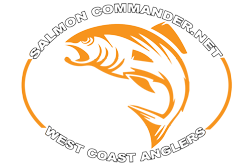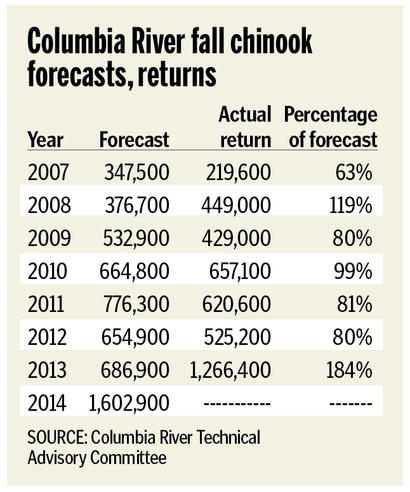“After decades of closures, recent years have seen the Columbia River returned to the dominant spring chinook fishery the world has to offer. It’s been an incredible transformation. Primarily, we owe the fishery to a change in ocean conditions that has been beneficial to fish survival, as well as fin clipping of hatchery stocks. Fin clipping allows anglers to identify hatchery-bred salmon, therefore marking them for harvest while troubled wild stocks are returned to the water unharmed.
The Columbia is a big river, and at first the task of locating fish may seem a sizeable challenge, and certainly, at times it can be. Like all fisheries though, you’re faced with a lot of potential water. And like virtually all fisheries, most of the water is of low potential and a small fraction makes up the good stuff.
The fall chinook fishery is much more familiar to anglers than spring chinook. The primary difference in approach to the two fisheries is due to the very different water temperatures the Columbia offers the two seasons. Fall chinook enter a hostile river where surface temperatures often reach and exceed the 70-degree mark (high temperatures are lethal to salmon). In order to negotiate the river safely, fall chinook travel deep, where cooler water collects.
Spring chinook enter a cold Columbia River. Temperatures in the high-thirties to mid-fifties place no restrictions on travel. With this in mind, spring chinook are found travelling in shallow water, say 9- to 25-feet in depth. In order to make travel as easy as possible, spring chinook dodge heavy head-on currents, travelling the river edges where the speed of the flow is reduced.
Running the edges of the river adds another great aspect to spring chinook in that bank fishing can be phenomenal. Travelling fish are within easy reach of bank gear and these fish respond very well to a plunked Spin-N-Glo, with maybe a bit of scent on it, or none at all.
With these basics, it seems easy to find spring salmon, and sometimes it can be, but throw in disruptions to flow due to tides and the full array of other forces that come into play in specific areas, and there is no set of principles that remain standing. To find productive spring salmon fishing throughout the Columbia River below Bonneville Dam and the Willamette River, you have to breakdown these fisheries into zones.
The Lower Columbia
For my purposes I’ll define the lower Columbia River as the stretch of water that begins at the upstream end of the estuary (Astoria area) and continues all the way to the mouth of the Sandy River to the east of Portland. With the exception of a few small runs heading to tributaries like the Lewis and Cowlitz Rivers, this huge expanse is travel water for the Spring Chinook heading to Willamette tributaries, as well as the Snake River and upper Columbia tributaries. In this big section, fish are on the move.
This section of river is also tidally influenced. Most prominently in the lower reaches with the river overcoming the tide with more power as you move up, tides play heavily into angling methods.
The best fishing is had on the outgoing tide. Whether the increased flow triggers movement in these fish, or simply concentrates them a tighter travel corridor, I’m unsure, but far, far more fish will be taken on an outgoing tide than an incoming.
What Makes The Difference
As a boater, there are three key elements that will make the difference in your day. The first is where you drop the anchor. In most of the hog lines out on the Columbia there will be lanes that are hot for fish travel, and consequently, the boat anchored in the right depth will be the benefactor of good placement while those on either side watch. When the fish gods are feeling gracious, the travel depth changes through the tide, spreading the bite around a little bit. But other times it’s a tight lane and the day comes down to the drop of the anchor. The second key element is your ability to tune a wrapped plug to swim properly. Spend time in this effort. Place your wrapped lure in the water and pull it forward, accelerating through the stroke. As you look down at it, if it pulls consistently to one side, you need to make changes. Nudge the top of the screw eye in the opposite direction that the plug favors, in very small increments. Retest after each change until the plug runs stable. Tuned lures catch fish. And finally, the quality of your sardine wrap comes in to play. Do not accept freezer burned bait. Look for packages that appear as if the fish was handled decently, not drug across the floor. Some anglers go as far as buying fresh, food quality sardines at specialty seafood stores. And perhaps plug color is a fourth aspect. In simple terms, every color is good as long as it has chartreuse involved.
From the bank, placement is equally important. Watch the casting distance of those anglers that are scoring. In this fishery, the longest cast does not always win. Doubling up the lure rigging by stacking two rigs, separated by three feet in between three-way swivels is not a bad plan, although if you tangle the rig, you’re not fishing. Good Spin-N-Glo colors include chartreuse/black, chartreuse/pink, chartreuse/orange (big surprises) and pearl pink.
Working The Incoming Tide
Predicting fish location on the incoming tide presents challenges. My best guess is that in the absence of the strong current created by the outgoing tide, the fish disperse throughout much more of the available water. Under a scenario of scattered fish, it’s time to troll.
Herring is the bait of choice on the Columbia. In the cold waters of the main river, spring salmon will take a herring with vigor. Use moderate action rods that offer a nice arc when fished with four ounces of lead. The moderate action will allow the salmon to chew on the bait while the rod continues to load, and when the fish moves off, he’ll hit the rod’s butt section and drive the hooks home, all by himself.
A standard herring setup includes a wire spreader or sliding weight rig, two feet of 15lb. dropper to the lead and a five or six foot leader of 25lb. monofilament to the bait. I run 50lb. braided mainline, though many prefer 25lb. monofilament on the troll for the stretch it provides on the strike.
Spring salmon respond well to dodgers and flashers. In recent years, in-line flashers like the Fish Flash and Kone Zone designs have caught fire from the ocean to tidewater to inland rivers. Easy to pull through the water, their fully rotating design puts off a lot of light. When fishing three rods, I like to have one of the forward rods with a flasher on it. If that rod goes off, I’ll try adding flashers to the other two rods. If the rod furthest from the flasher gets bit, I might remove the flashers altogether. On any given day, I’ll try to let the fish dictate what they like.
Target water for trolling on the Columbia is comprised of the many flats that lie at the heads of islands and to the sides of the shipping channel. Again, these fish are not confined by warm water temperatures, so don’t be afraid of the shallow flats that are only ten to fifteen feet deep. As a rule of sorts, I’ll focus on water from ten to twenty-five feet deep. Every year though, many fish will come from water shallower than even ten feet. In these shallow areas, position the bait just a crank or two of the reel handle off of the bottom.
Much of the talk about herring fishing centers on the “spin” that is most desirable to fish. After years of anguishing over the topic, I’ve found my comfort zone in a fast, tight, “bullet” style spin. Where this is commonly referred to as a coho style bait, it’s become my choice for all species of salmon. To speed up the spin of a bait, the hook that holds the forward end of the cut plug is placed in line with the backbone of the bait fish, or slightly to the longer side.
What Makes the Difference
Three key elements to trolling success are: location, troll speed and bait quality. As for locations out on the Columbia, I’d be pretty certain that at this stage in the fishery, there are more quality spots available than are being currently fished. There’s a lot of river out there, and this is a young fishery. In terms of troll speed, we’ve all been ingrained that for chinook, your troll speed should be dead slow. We’re learning however, that many of the top rods troll fast. If the goal is to cover water, troll with the flow of the current, pick up the pace a bit, and get your bait in front of as many potential biters as possible. Good bait goes without saying. In cold water there really isn’t a need for brines as baits will stay together well. Choose quality vacuum-packed herring. Beyond that, look for clear eyes in the bait, as well as those baits with a minimum of scale loss. Pay attention to the details and the success will come.
Where To Go
Places to fish are surely abundant, but I’ll throw a few areas out where you are sure to see other anglers, and fish being caught, so you can get a feel what makes a great spot. Starting low is Tenasillahe Island. Anchor fish the north side, troll on the shallower south side. Reach this area, along with Puget Island from the Westport launch in Oregon, Cathlamet in Washinton. The next major fishery is the Longview/Rainier area (Cowlitz mouth). Launch in Rainier and run down to the islands or up around the first corner and you’ll be in the thick of it. From there you’ll find fisheries at the mouth of the Kalama River, Lewis River, around St. Helens, Frenchmans Bar and the mouth of the Sandy River. How do you choose an area? I pick where I’m going by which area affords the tide I’m looking for. The effects of the tide move upriver slowly, with different locations separated by hours. Either adjust your trip by when the tide is, or adjust your location by what the tides offer. ”

